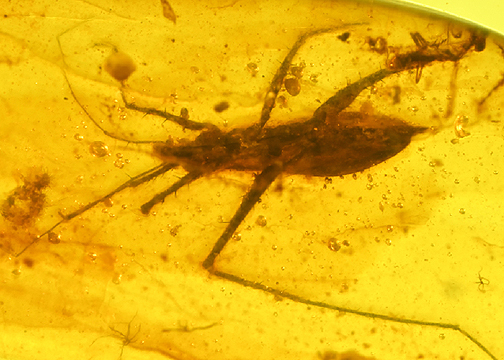Abstract
Myanmarvelia pankowskiorum gen. et sp. nov., is the first occurrence of the aquatic bug family Mesoveliidae in the mid-Cretaceous Kachin amber. This new taxon is described and illustrated based on a well-preserved female specimen. Although numerous morphological characters confirm its placement in the Mesoveliidae its position within the family is unclear. The presence of claws inserted pre-apically and head extended in front of eyes would suggest a placement in the Mesoveliinae but we consider it putative. The fossil record of this family is very poor, ranging between the late Jurassic and the Miocene.
References
- Andersen, N.M. (1982) The semiaquatic bugs (Hemiptera: Gerromorpha): phylogeny, adaptations, biogeography and classification. Entomonograph, 3, 1–445.
- Andersen, N.M. (1998) Water striders from the Paleogene of Denmark with a review of the fossil record and evolution of semiaquatic bugs (Hemiptera, Gerromorpha). Biologiske Skrifter, 50, 1–157.
- Andersen, N.M. & Polhemus, J.T. (1980) Four new genera of Mesoveliidae (Hemiptera: Gerromorpha) and the phylogeny and classification of the family. Entomologica Scandinavica, 11, 369–392. https://doi.org/10.1163/187631280794710060
- Andersen, N.M. & Polhemus, D.A. (2003) A new genus of terrestrial Mesoveliidae from the Seychelles (Hemiptera: Gerromorpha). Journal of the New York Entomological Society, 111, 12–21. https://doi.org/10.1664/0028-7199(2003)111[0012:ANGOTM]2.0.CO;2
- Berchi, G.M., Kment, P., Copilaş-Ciocianu, D., Rákosy, L. & Damgaard, J. 2016. Water treaders of Romania and adjacent countries and their phylogenetic relationships (Hemiptera: Heteroptera: Mesoveliidae). Annales Zoologici, 66, 193–212. https://doi.org/10.3161/00034541ANZ2016.66.2.004
- Cruickshank, R.D. & Ko, K. (2003) Geology of an amber locality in the Hukawng Valley, Northern Myanmar. Journal of Asian Earth Sciences, 21, 441–455. https://doi.org/10.1016/S1367-9120(02)00044-5
- Damgaard, J. (2012) What do we know about the phylogeny of the semi-aquatic bugs (Hemiptera: Heteroptera: Gerromorpha)? Entomologica Americana, 118, 81–98. https://doi.org/10.1664/12-RA-030.1
- Damgaard, J., Moreira, F.F.F., Hayashi, M., Weir, T.A. & Zettel, H. (2012) Molecular phylogeny of the pond treaders (Insecta: Hemiptera: Heteroptera: Mesoveliidae), discussion of the fossil record and a checklist of species assigned to the family. Insect Systematics & Evolution, 43, 175–212. https://doi.org/10.1163/1876312X04302004
- Esaki, T. (1929) A remarkable speo-halophilus water-strider (Mesoveliidae). Annals and Magazine of Natural History, (10), 4, 341–346. https://doi.org/10.1080/00222932908673063
- Garrouste, R. & Nel, A. (2010) First semi-aquatic bugs Mesoveliidae and Hebridae (Hemiptera: Heteroptera: Gerromorpha) in Miocene Dominican amber. Insect Systematics & Evolution, 41, 93–102. https://doi.org/10.1163/187631210X496822
- Grimaldi, D. & Ross, A.S. (2017) Extraordinary Lagerstätten in amber, with particular reference to the Cretaceous of Burma. In: Fraser, N.C. & Sues, H.D. (Eds), Terrestrial conservation Lagerstätten: windows into the evolution of life on land. Dunedin Press, Edinburgh, pp. 287–342.
- Jehamalar, E.E., Chandra, K. & Polhemus, D.A. (2019) Review of the Mesovelia horvathi species complex (Hemiptera: Gerromorpha: Mesoveliidae), with the description of seven new species from India. Zootaxa, 4651 (3), 471–496. https://doi.org/10.11646/zootaxa.4651.3.4
- Jell, P.A. & Duncan, P.M. (1986) Invertebrates, mainly insects, from the freshwater, Lower Cretaceous, Koonwarra fossil bed, (Korumburra Group), South Gippsland, Victoria. In: Jell, P.W. & Roberts, J. (Eds), Plants and invertebrates from the Lower Cretaceous Koonwarra fossil bed, South Gippsland, Victoria. Memoirs of the Association of the Australasian Palaeontologists, 3, 111–205.
- Malipatil, M.B. & Monteith, G.B. (1983) One new genus and four new species of terrestrial Mesoveliidae (Hemiptera: Gerromorpha) from Australia and New Caledonia. Australian Journal of Zoology, 31, 943–955. https://doi.org/10.1071/ZO9830943
- Mao, Y.Y., Liang, K., Su, Y.T., Li, J.G., Rao, X., Zhang, H., Xia, F.Y., Fu, Y.Z., Cai, C.Y. & Huang, D.Y. (2018) Various amberground marine animals on Burmese amber with discussions on its age. Palaeoentomology, 1 (1), 91–103. https://doi.org/10.11646/palaeoentomology.1.1.11
- Nel, A., Nel, P., Krieg-Jacquier, R., Pouillon, J.-M. & Garrouste, R. (2014) Exceptionally preserved insect fossils in the Late Jurassic lagoon of Orbagnoux (Rhône Valley, France). PeerJ, 2 (e510), 1–16. https://doi.org/10.7717/peerj.510
- Poisson, R.A. (1959) Sur un nouveau représentant africain de la faune terrestre commensale des biotopes hygropétriques: Madeovelia guineensis gen. n., sp. n. (Heteroptera). Bulletin de l’Institut Français d’Afrique Noire, (A), 21, 658–663.
- Polhemus, J.T. (1975) New estuarine and intertidal water striders from Mexico and Costa Rica (Hemiptera Gerridae, Mesoveliidae). The Pan-Pacific Entomologist, 51, 243–247. https://biostor.org/reference/232539
- Polhemus, J.T. & Polhemus, D.A. (1989) A new mesoveliid genus and two new species of Hebrus (Heteroptera: Mesoveliidae, Hebridae) from intertidal habitats in South East Asian mangrove swamps. Raffles Bulletin of Zoology, 37, 73–82.
- Sánchez-García, A., Nel, A., Arillo, A. & Solórzano-Kraemer, M.M. (2017) The semi-aquatic pondweed bugs of a Cretaceous swamp. PeerJ, 5 (e3760), 1–32. https://doi.org/10.7717/peerj.3760
- Shi, G.H., Grimaldi, D.A., Harlow, G.E., Wang, J., Wang, J., Yang, M.C., Lei, W.Y., Li, Q.L. & Li, X.H. (2012) Age constraint on Burmese amber based on U-Pb dating of zircons. Cretaceous Research, 37, 155–163. https://doi.org/10.1016/j.cretres.2012.03.014
- Solórzano-Kraemer, M., Perrichot, V., Soriano, C. & Damgaard, J. (2014) Fossil water striders in Cretaceous French amber (Heteroptera: Gerromorpha: Mesoveliidae and Veliidae). Systematic Entomology, 39, 590–605. https://doi.org/10.1111/syen.12077
- Yao, Y.Z., Zhang, W.T. & Ren, D. (2012) The first report of Mesoveliidae (Heteroptera: Gerromorpha) from the Yixian Formation of China and its taxonomic significance. Alcheringa: An Australasian Journal of Palaeontology, 36, 107–116. https://doi.org/10.1080/03115518.2011.585543
- Yu, T.T., Kelly, R., Mu, L., Ross, A., Kennedy, J., Broly, P., Xia, F.Y., Zhang, H.C., Wang, B. & Dilcher, D. (2019) An ammonite trapped in Burmese amber. Proceedings of the National Academy of Sciences of the USA, 116, 11345–11350. https://doi.org/10.1073/pnas.1821292116
- Zettel, H. (2004) Phrynovelia philippinensis sp. n. (Heteroptera: Mesoveliidae) von der Insel Polillo, Philippinen. Linzer Biologische Beiträge, 36, 1353–1358.


